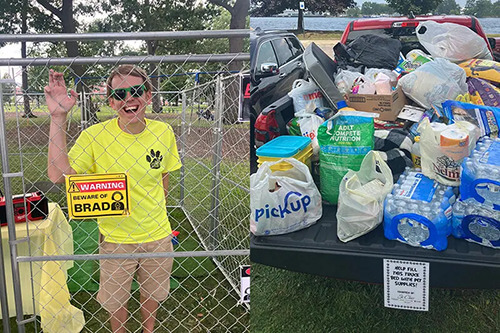Community Service Report
Michigan Broadcasters Serve Michigan Communities
For local radio and television stations, community service is more than a passing concern. It is a way of doing business. Everyday in Michigan, from Detroit to Escanaba and everywhere in between, broadcasters are going to bat for community charities, educating residents about important local issues, delivering life-saving information in times of disaster, and continually renewing their commitment to their communities.
One of the main missions of the MAB is to help their members serve their communities better. In doing this we seek out issues of statewide importance which have been identified by individuals and lawmakers to help. MAB members work collectively on a volunteer basis to educate listeners and viewers on the important issues through the airing of on-air messages. No other industry has the impact on local communities like free over-the-air broadcasting. Michigan radio and television stations understand the importance of community service. They live it every day.
Districts 1-2




WUPT-FM (Marquette)
The Radio Results Network in Marquette hosted a Takeover Tuesday series in October, 2023 as a part of their new partnership program with Radio X (91.5 WUPX), Northern Michigan University’s student-run radio station. The Takeover Tuesday series created opportunities for students to further their experience in the broadcasting industry and further connect with their local community.


WZMQ-TV (Marquette)


In 2023, WCMU donors generated more than 1,700 meals, and in 2022, more than 8,000 meals without a ‘Gift of Food’ sponsor. WCMU General Manager Rick Westover is hopeful for an even greater impact this year. “Our goal is to see 10,000 meals with the help of Mercantile Bank,” said Westover. “It’s a wonderful opportunity to help our neighbors and make a real difference during the season of giving, and listener donations make it all happen.”


WION-AM (Ionia)


WION-AM (Hastings)
WBCH-AM/FM in Hastings partners with Barry County United Way to help ensure area children receive gifts at Christmas. WBCH’s annual S-O-S: Stuff Our Station community service project collected toys and gifts for toddlers through teens and ‘stuffed’ the front windows of the stations’ downtown studios for distribution by United Way volunteers to families in need. This year WBCH listeners and other community partners donated enough gifts to help nearly 600 area children at Christmas. Any leftover presents are given throughout the year by Barry County United Way and local law enforcement to children and families who suffer loss or traumatic events. WBCH has also kicked off a yearlong safety awareness campaign stressing Michigan’s Emergency Vehicle Caution Law after the community was shocked in November 2023 by the death of a local wrecker operator. WBCH is running frequent announcements to remind listeners to “Slow Down and Move Over – It’s the Law.”


WCFX-FM (Mt. Pleasant)
On October 23, 2024, Black Diamond Broadcasting's WCFX-FM raised over $37,000 for Community Cancer Services of Isabella County with the station's annual ”2024 CFX Bras for a Cause presented by Graff Mt Pleasant." Over 20 local men stepped up and modeled custom bras to be auction off to help raise funds. The bras were created by local businesses and groups. The event was held at O'Kelly's Sports Bar & Grille and was co-sponsored by Mr. Rooter Plumbing of Mid-Michigan, McLaren Central Michigan, and Herbs Etc Michigan along with title sponsor Graff Motors. The fundraiser recieved a very generious donation to the effort from General Agency Company, who's staff raised money ahead of time.


WMOM-FM & WHCH-FM (Ludington)
Hit Radio Media's WMOM-FM/WHCH-FM (Ludington) has announced that it raised $18,469.71 with its "Ludington Area Festival of Lights," held from November 27 through December 29. The announcement came January 9 during a presentation at Safe Harbor Credit Union in Ludington. The presentation, attended by more than 100, recognized business sponsors, volunteers, community members, contestants as well as students from Gateway to Success Academy and Ludington High School Industrial Arts Class. A key highlight of the ceremony was the presentation of checks to four local non-profits, who together received 50% of the gate proceeds. Cash awards were also presented to winners of the festival's interactive competitions, which encouraged creativity and community engagement. Owner and General Manager Chris Nicholas told the MAB that he had a vision of creating a holiday experience that would unite the Ludington community and this year’s Festival of Lights turned that vision into a reality. From its inception to its execution, Nicholas led the charge, organizing an event that captured the hearts of over 20,000 visitors and showcased Ludington’s generosity, creativity, and collaborative spirit. The effort took a village of volunteers, businesses, and organizations to bring it to life. Nicholas said that local companies like At The Peak Roofing played a pivotal role, taking responsibility for decorating the trees and office area at the heart of the Festival, while Nicholas and his team designed and created the entire first and second half of the drive thru. This beautifully lit centerpiece seamlessly connected the first half of the event to the second, creating a striking transition that visitors loved. Along with the support of local companies, a sizable contribution from the radio stations ensured the success of the Festival. The stations purchased all the items used during the event so they remain in the Ludington community, allowing the Festival to grow and improve each year with new additions. This collaboration ensures the Festival will continue to be a cherished holiday tradition for years to come.
Districts 3-4


WGHN-AM/FM (Grand Haven)








WXMI-TV (Grand Rapids)
WXMI-TV FOX 17’s A Path Forward brings together law enforcement, the business community, and many non-profits as part of a Community Advisory Board, to build connections and lift up teens for a safer West Michigan by showcasing resources, changing the way the news department shares these stories, and establishing partnerships that offer real opportunity for the young people in our community. One way WXMI-TV is doing that is with the Boys and Girls Club of Grand Rapids, not only in fundraising at the Be Great Tailgate, but in sharing stories about young people who are growing and thriving because of its programming


WSJM-FM, WIRX-FM, WCSY-FM, WYTZ-FM, WCXT-FM, WQYQ-AM & WQLQ-HD2 (Benton Harbor)
For the past 27 years, Mid-West Family Southwest Michigan has worked side by side with the Southwest Michigan Community Action Agency to help receive donations in the form of food, personal care items, and cash to support the tremendous need here in our community. The radio stations broadcast live Monday through Friday from 6a-6p at a local grocery store, asking for donations. This year, a significant amount of food and personal care items were donated and the initiative raised just shy of $50,000 cash, enough to cover their need for half the year. Without this initiative the SMCAA would struggle mightily to fill the need in the southwest Michigan community.


WHTC-AM/FM & WYVN-FM (Holland)
Midwest Communication’s WHTC-AM/FM & WYVN-FM sponsored the Alzheimer’s Walk of Holland which helped to spread awareness about the important cause. WHTC Morning News & WHTC Brand Manager Dan Evans emceed the event.


WWMT-TV (Kalamazoo)
WWMT News Channel 3, Versiti, and the Heart of Michigan Girl Scouts hosted a blood drive in April with 40 donors, 38 donations were collected, and 114 lives were saved, according to Versiti. Thirty of the 40 donors who participated in the blood drive were brand new donors to Versiti, organizers said.


Townsquare Media
WKFR-FM & WRKR-FM (Kalamazoo)
On May 16-18, 2024, Townsquare Media's WKFR-FM hosted their annual Roof Sit event, that raises awareness and funding to treat and prevent child abuse and neglect in Southwest Michigan. This year the event raised more than $83,000 for the Community Healing Center's Children’s Programs. Radio personalities from WKFR broadcast live from the Roof Sit site in Portage. WWMT-TV's Jessica Harthorn and Keith Thompson served as emcees for the event. For 26 years, Kalamazoo Community Healing Centers has been partnering with WKFR to raise money and awareness for the treatment and prevention of child abuse and neglect in Southwest Michigan.
From October 22 through November 22. 2-24, WRKR-FM (Portage/Kalamazoo) held "Rocker 2 The Rescue" and staged its first-ever radiothon, benefiting Catholic Charities Diocese of Kalamazoo. The effort was to raise money for charities that support families in Southwest Michigan as well as "hooking up the station's audience with tons of gifts for the holidays." Throughout the month-long effort, the station's morning show did daily check-ins with different charities supported by Catholic Charities. On November 22, the station wrapped up the fundraiser with a day-long broadcast 6 a.m. to 7 p.m. broadcasting live from Presidential Brewing Company in Portage for its first-ever radiothon, and giving out gifts all day long to listeners just for stopping by and saying hello.


Photo credit: Free Beer & Hot Wings/Facebook
Townsquare Media
WGRD-FM (Grand Rapids)
On August 8, 2024, WGRD-FM's morning show "Free Beer and Hot Wings" held a 12-hour commercial-free "Fill the Basket" radiothon to raise money for the nonprofit Kids Food Basket, which serves Kent, Ottawa, Muskegon and Allegan counties. During the radiothon, listeners heard stories of the people impacted by the organization's work and were be encouraged to donate. A total of $129,942.90 was raised, more than three times the original goal. "Our goal (was) to raise $37,000 which is enough to fund one school to receive daily sack supper meals for an entire year," said Kids Food Basket chief operating officer Erika Abbo told WZZM-TV. "Last year, we served about 10,000 evening meals each weekday to 60 schools across West Michigan, and so we are really just looking for the community support to continue to be able to expand that work." Kids Food Basket works with 60 schools, but Abbo says they're only serving about 12% of the need in the community. Support from events like the radiothon could help them do even more. "It's about knowing that, on a day-to-day basis, as children are leaving school, they can count on that meal. That meal is going to be there for them, and we are going to show up each and every day. That meal is going to go home with them, and it's going to be filled with food that they enjoy, that they've taste tested, that is kid-approved, and that is good for their bodies to really help them to be their best selves as well," Abbo said.
Districts 5-6


WSDP-FM (Plymouth-Canton)
WSDP-FM 88.1 The Park, Plymouth-Canton’s student-run radio station positively impacted the local community throughout the year via partnerships with community leaders. The Penn Theatre Movie Series sponsorship allowed an excellent opportunity to support one of Plymouth’s local treasures as they work to continue serving the community. The station served as the soundtrack for a day-long Mental Health and Wellness Fair and demonstrated their service to the community through airing public service announcements and news stories leading up to the event. WSDP-FM 88.1 The Park was also proud to use their airwaves to help a student-led SJ5K Charity Run pass the million-dollar mark, benefiting families facing medical hardships.


WUOM-FM (Ann Arbor)
Michigan Public partnered with several community organizations on June 17, 2023 to present Navigating a Mental Health Crisis. This free event helped provide Detroit residents with tools and resources to identify and respond to a mental health crisis. The event helped Detroiters become better equipped to handle crisis situations, informed residents when and when to not call the police, gave guidelines on who to call in a crisis, and shared what long-term support is available. Partners for this event included Detroit Wayne Integrated Health Network and Wayne State University.


Lenawee Broadcasting Company & Southeast Michigan Media, Inc.
WLEN-FM & WQTE-FM (Adrian)
On November 11, 2024, Lenawee Broadcasting Company and Southeast Michigan Media held their 19th annual Thank-A-Vet fundraising event outside their studios in downtown Adrian. The event, held live on-air from 6a-6p, raised $55,179.45 for local veterans. This surpassed the record $48,000 raised in 2022. WLEN staff, local veterans’ organizations, and area business people stood curbside outside the station studios and collected funds to support local veterans. These funds are distributed throughout the year to local veterans for assistance with rent, mortgage payments to avoid foreclosure, utility bills, rental facilities to store possessions when they are displaced, transportation stipends, and for things as simple as a pair of boots to secure employment. Since 2006, the stations have raised over $500,000 to help local veterans.


WCSR-AM/FM (Hillsdale)
On December 13, 2024, personalities from Radio Hillsdale WCSR-FM and The Dale (WCSR-AM/W258DE) rang bells for the Salvation Army's Red Kettle Campaign at the Hillsdale Market House. From 10 a.m. - 5 p.m. listeners, station partners, and the community made donations totaling $6,248.12! Crew from the station included station manager and WCSR Midday Buffet host, Juli Hays; Morning Mo'Joe's Jake V. and Russ Martin (Martin also hosts Country Fried Afternoons on The Dale), Harrison James from Post Meridian, as well as Emma Rae from The Dale's midday show.


WBET-FM (Sturgis)
On May, 23, 2024, WBET-FM held their 15th annual Radiothon to benefit the St. Joseph County United Way recently and the event broke all previous year’s numbers with a record breaking $165,508.00 raised over an 18-hour period. The radiothon took place 6am-12am with 18 different celebrity DJs on-the-air to encourage donations. There was also a silent auction. For a market this small, the continued local support of the WBET Radiothon has been nothing short of amazing. It also shows once again the power and connection that local radio can have on its’ community. In 2022, the station raised $144,000 for St. Joseph County United Way. In 2023 the total was $157,300!
District 7


WILX-TV (Lansing)
WILX-TV News 10’s Make an Impact initiative is designed to raise awareness, raise funds, and collect supplies for community organizations across Mid-Michigan using the full power of the television station and digital properties to make a real difference. Each campaign ends with an extensive one-day blitz including a telethon from the News 10 Call Center. This initiative has supported causes by collecting boots, blood, diapers, books, defibrillators, bunkbeds, turkeys, backpacks, toys, food, and pets supplies - to just name a few! To date, Make an Impact has raised hundreds of thousands of dollars that have gone back into the community, plus countless physical donations.


Nexstar Media Group, Inc.
WLNS-TV (Lansing)
In the summer of 2024, Nexstar Media's WLNS-TV (Lansing) held their 2024 Operation Backpack campaign. The station partnered with Catholic Charities of Ingham, Eaton and Clinton Counties and Catholic Charities of Jackson, Lenawee, and Hillsdale Counties to collect school supplies for local children, including foster children, adopted children, refugees, and others who may need assistance.
Supplies were collected from July 15 through August 8. The station had a drop-off locations throughout the Lansing region, but also offered options to donate online or via an Amazon wish list. WLNS also made a cash donation of $500 toward this year's effort.


E.W. Scripps Company
WSYM-TV (Lansing)
In keeping with its mission to help prepare children for their educational futures, the Michigan Education Trust (MET) joined WYSM-TV (Lansing) and the Scripps Howard Fund on March 4, 2024 in delivering free books to a Lansing elementary school. The books were delivered during a book fair at Vivian Riddle Elementary School, 221 Huron St., in Lansing, as part of a book donation effort that began last fall. The school currently also houses students from Willow Elementary while a new school is under construction. At the book fair, which coincided with National Reading Month in March, each student received five free books from the Scripps Howard Fund and its partnership with MET and WYSM. Each of the employees at FOX 47 has helped to make donations to buy all of this and it's really crazy and a point of pride for all of us," said station manager Gary Baxter. MET Marketing Manager Heather Barthelmes, who attended the event with MET’s mascot, Whoodini, congratulated the Scripps Howard Fund for its work and for reaching a milestone last year in its “If you give a child a book” campaign by distributing its 1 millionth book. “Michigan Education Trust has been a proud sponsor of this campaign with WYSM and Scripps Howard,” Barthelmes said. “We look forward to helping the Scripps Howard Fund team lean into distributing another million books moving forward.” MET Deputy Director Megan Patino called the partnership a “perfect pairing with MET’s underlying mission, which is to prepare children for their future educational needs.” “Having books on the shelves in your home lays the groundwork for your child’s educational future in the same way that saving money for school does,” Patino said. For 35 years, MET has been providing families peace of mind as they work, plan and save to help provide their children with a debt-free start to pursue their dreams by letting people purchase future educational needs at today’s prices.


WJXQ-FM (Holt)
Midwest Communications’ WJXQ-FM partnered with the Lansing Food Bank to help needy families over the holiday season. Listeners were invited to donate 50 pounds of food, or $50 in cash in exchange for picking any song to be played on the station that day. Cash donations totaled $3,500 and multiple tons of food
were collected.


WITL-FM (Lansing)
Townsquare Media's WITL-FM held its annual listener Christmas party on December 10, raising more than $7000 for Ele's Place. Ele's Place is a nonprofit, community-based organization dedicated to creating awareness of and support for grieving children, teens and their families. The event, held at Grewal Hall in downtown Lansing featured acoustic performances from country artists Corey Kent, Ashley Cooke, Runaway June. Singer-songwriter John Morgan had been scheduled to be part of the event, but had to cancel at the last-minute. All three acts took the stage simultaneously and took turns singing their hits and other favorites. According to a post on the station's website, Corey Kent kicked off the night with an acoustic version of his single "This Heart", also performing his hits "Something's Gonna Kill Me" and "Wild As Her" among others. Ashley Cooke included her #1 hit "Your Place" and a cool cover of "Last Christmas". Runaway June's new song "He Ain't My Problem" was a crowd favorite, as was their hit "Buy My Own Drinks". 100% of the ticket sales went to Ele's Place.


WHMI-FM (Howell)
On October 10, 2024, Krol Communication's WHMI-FM (Howell), in partnership with American Legion Devereaux Post 141 held a day long Hurricane Relief Drive to benefit those impacted by Hurricane Helene. The drive, hosted by WHMI Morning Show hosts Chuck Edwards & Madison June on Thursday took place live at the Legion post from 6:00 a.m. to 6:00 p.m. The relief effort is to support those who are in desperate need of basic necessities including but not limited to: blankets, hygiene products, diapers (child & adult) water, non-perishable food items and more. There were even donations of generators! All-in-all, there were more than 500 individual donors with an estimated $200k worth of donated items, enough to fill two 26' box trucks fully loaded! In addition, there was another $8k in monetary donations toward recovery efforts. WHMI morning show host Chuck Edwards commenting: “Madison and I feel compelled to help our fellow Americans in this dire, heartbreaking circumstance. We know the people who listen feel the same way." A later post on the station's website summed it up: "Unbelievable turnout for our very first WHMI Cares Radiothon! 12 hours on the air...live and local! This is the power of of our community. We are stronger together! Sending love from Livingston County to the Hurricane Helene victims. Thank YOU ![]() The trucks leave tomorrow!!
The trucks leave tomorrow!!
Districts 8-9


WSGW-AM/FM, WCEN-FM, WTLZ-FM, & WGER-FM (Saginaw)
Alpha Media's WSGW-AM/FM (Saginaw) held its 19th annual Sharing Hope radiothon on December 12, 2024 to benefit rescue ministries in Mid-Michigan. Money raised during the 12-hour radiothon will help City Rescue Mission in Saginaw and the Good Samaritan Rescue in Bay City provide people in need things like a warm bed, food, clothing and counseling. Three new rescue ministries will benefit from the radiothon this year as well: Impact Designs, Samaritan Youth Shelter and Labadie Lofts. "There were over 200 people last night that stayed at the rescue mission in Saginaw or the rescue mission in Bay City. And without the mission those people would probably be out in these harsh conditions," said radiothon coordinator Bill Hobson. "So this day is about providing days of hope and care for everybody in need." The radiothon goal this year was to raise at least $60,000 and donors exceeded that with a grand total of $66,650.


WRSR-FM (Flint)
On March 1, 2024, Krol Communication's WRSR-FM (Flint) held its Fox Feeding Frenzy, an annual event to raise funds for The Food Bank of Eastern Michigan. This year set a new record for the event, with contributions from station listeners reaching $68,193. The dollar amount equals 409,158 meals for our friends and neighbors in our community who are struggling with food insecurity! The event is the Food Bank's kickoff to their annual March Against Hunger campaign. Program Director and Afternoon Host Jeremy Fenech said, "Thank you, Mid-Michigan! With your help and the support of our sponsors we broke our all-time one-day record with this year’s Fox Feeding Frenzy!" The 12-hour broadcast aired 7a.m. to 7p.m. from the station studios. The Food Bank of Eastern Michigan provides food and water for it’s 415 partner agencies in 22 counties across Michigan. WRSR personalities were on the air live encouraging listeners (known as “Hunger Heroes”) to phone their pledge in.
On December 8, 2023, WRSR-FM held an 11-hour radiothon to benefit the Old Newsboys of Flint, a local nonprofit who's mission is to "Let no child be forgotten" during the Christmas season. With help from sponsors like Streeter Brothers Concrete Contractors of Burton and the Shea Automotive Group, the station was able to raise $31,016.79 through donations and sponsorships. That total alone helped more than 1,550 kids get a Christmas in Genesee County.


WCRZ-FM (Flint)
Townsquare Media’s WCRZ-FM raised $94,000 for Whaley Children’s Center (WCC) during the station’s 8th annual Roof Sit, held July 12-14, 2023, atop the downtown Grand Blanc McDonald’s. The goal of the annual three-day fundraiser was to raise awareness and donations for the needs of the 42 foster children currently living at WCC. The WCC is an independent, 501(c)3 nonprofit, nearly 100 years old, which works to provide every child with a comfortable and living home. They provide residential childcare for children five to 17 years old who have suffered chronic abuse and neglect, provide counseling, aftercare services, and more.


WHLS-AM/FM and WSAQ-FM (Port Huron)
On August 15, 2024. Liggett Communication's WHLS-AM/FM partnered with the Blue Water Area Humane Society for the third year of Rockin' the Rescue, a day-long fundraising and awareness event. As over the last two years, station personality Brad Biewer broadcast live from inside a modified dog kennel for 6 hours to collect donations for the local shelter. This year, the effort raised $2500 plus a truck bed of donated pet supplies. Over the past three years now, WHLS has raised over $10,000 and has donated over three truckloads of pet supplies to the Blue Water Area Humane Society.
Liggett Communication’s WSAQ-FM held their annual Community Roof Sit to benefit the Child Abuse and Neglect (CAN) Council from September 9-13, 2024. Station staff lived on top of the MiMutual Building in downtown Port Huron to raise funds and awareness for child abuse prevention and advocacy. The station, with help from listeners and other community organizations, helped raise $167,000 to support the work of the CAN Council.


WEYI-TV, WSMH-TV & WBSF-TV (Flint)
Mid-Michigan NOW, Dort Financial Credit Union, and Catholic Charities of Shiawassee and Genesee Counties teamed up to help those in need for the 13th annual 25 Days of Giving. Through the month of December, donations for non-perishable food items, personal care items, and winter coats, hats, gloves, and mittens were accepted at Dort Financial Credit Union branches throughout the region. Catholic Charities relies heavily on donations, which are distributed to those in need.


WNEM-TV (Saginaw)
In March 2014, the Saginaw Spirit hockey team was devastated to learn player Terry Trafford had taken his own life. Since then, it has been the mission of the Saginaw Spirit to prevent suicide through education, connection to resources, and support for those impacted by suicide. WNEM TV5, along with the Barb Smith Suicide Resource & Response Network, hosts a live phone bank encouraging viewers who may be struggling to make that call that could save their life. During the 5p, 5:30p, and 6p News, the station airs a :90 interview with a resource member and a running crawl with an 800 number directing viewers to call. On February 9, 2023, the station hosted the Talk Today, Hope for Tomorrow Mental Health phone bank. The Saginaw Spirit, the Trafford Family, and the Barb Smith Suicide Resource & Response Network came together to turn this tragedy into a legacy that will help so many. The professionals who were at WNEM TV5 answering the calls were able to help several critical people and even had staff from the Saginaw Spirit assisting in looking up phone numbers and resources while the experts were on the phone.


WKQZ-FM (Saginaw)
Cumulus Media has announced that Z93/WKQZ-FM (Saginaw) and station Program Director Matt Bingham have raised over $30,000 in community donations during the American Cancer Society’s Men Wear Pink annual fundraising campaign. All funds raised benefit the American Cancer Society in Mid-Michigan and the fight against breast cancer. Z93 set a new fundraising record for Mid-Michigan, landing Bingham and the station in the Top 30 Men Wear Pink ambassadors nationwide. Together, they have participated in Men Wear Pink for the last six years, raising a total of more than $90,000, which helps fuel a live 24/7 helpline for answers and support, breakthrough breast cancer research, and much more. Matt Bingham, Z93 Program Director and Co-Host, “The Morning After with Matt and Adam,” said: “It’s tough to put into words how much it means to set a new record in Mid-Michigan of $30,025 raised through Men Wear Pink for the American Cancer Society, but I know I couldn’t have done it on my own. We would not have surpassed our goal without the help of both our listeners and the countless local businesses that offered up fundraising opportunities. It truly was a team effort and I’m excited to see how much we can raise next year!’ Ashley Wellman, Senior Development Manager, Michigan, for the American Cancer Society, said: ‘We are so thankful for everything that Matt Bingham and the Z93 team have done during their Men Wear Pink campaign over the last six years! Each year, Matt has set a new standard and been able to increase his fundraising totals from the year before, while engaging new people in the community. The team at Z93 has been instrumental in helping the American Cancer Society not only raise life-saving funds but also create more awareness around life-saving cancer screenings, resources, and patient support programs. He has been able to help us reach a wider audience then we would have been able to do on our own.” Wellman added: “You can tell that Matt and the team at Z93 have created amazing longstanding relationships with listeners and businesses in the area. We are so grateful to work with such generous supporters of the American Cancer Society, who understand our mission to end cancer as we know it, for everyone.”
Districts 10-13


Mike Murri
E.W. Scripps Company
WXYZ/WMYD-TV (Southfield)
In early February, 2025, Scripps Media's WXYZ-TV/WMYD-TV (Detroit) has announced the kickoff of the 2025 "If You Give A Child A Book" campaign. Employees at the stations along with the Scripps Howard Foundation, have made it their mission to get high-quality books to the children in their community. This past summer, the station did a call-out for donations from employees and the community. With those collected funds and with a matching contribution from the Scripps Howard Foundation, they are able to give more than 20,000 books to children in the community this year. In partnership with the United Way for Southeastern Michigan and Scholastic, WXYZ-TV is distributing books at partner schools in the Detroit and metro Detroit area through various events and book drive-thrus. Books are chosen to be specific to each school and classroom. “It does get bigger and better every year, and I can't think of a better way to start the year out than with our 'If You Give A Child A Book' campaign,” said Mike Murri, WXYZ-TV & WMYD-TV20 Detroit vice president and general manager. “Because of the generosity from our community, our employees, we're able to start this year out by distributing over 20,000 new, age-appropriate books to children in metro Detroit — and the need has never been greater. The impact is tremendous, it's transformative for these children.” The book giveaway events started this week with a kickoff book drive at Pepper Elementary in Oak Park. Each student was able to pick out five brand new books.


WWJ-TV (Southfield)
CBS Detroit staff volunteered at Camp Care in Macomb County which is a camp for children with parents suffering from addiction. Staff were able to see a typical day at camp for the children, ranging from five to 18, and talk to them about camera operations and storytelling. CBS Detroit’s Amyre Makupson was the keynote speaker for the Empowerment Plan’s 10-year anniversary gala. The empowerment plan creates coats that turn into sleeping bags for the homeless. In 2023, the nonprofit made over 11,000 coats. The station also created a Michigan Made tree to solicit votes for the Alzheimer’s Association Greater Michigan Chapter through Gardner White. Anchor Amyre Makupson spoke to local businesses and artisans to collect locally created ornaments and spoke to the community about Alzheimer’s at the Twinkletown Gala.


WJBK-TV (Southfield)
Over the course of the year, FOX 2 supports more than 100 community causes that impact their viewing audience. The station’s biggest project of the year is fighting food insecurity. No child should go to bed hungry, but the reality is that one in five children in the community faces hunger. That’s why FOX 2 teams up with Gleaners Community Food Bank all year long. In 2023, the station produced four one-day telethon events to help inspire viewers to support the food bank. In total, the four events raised almost $1.3 million. All those donations were matched by sponsors for a grand total of more than $2.5 million. Every dollar goes to feeding hungry families, seniors, and children in the community. FOX 2 also partnered with Gleaners for a Hunger Free Summer Campaign because when school is out many children go hungry. More than 30 employees gave time on a Saturday morning to pack food boxes for Gleaners Mobile Pantries. Those mobile distributions go into the community bringing food directly to hungry neighbors. In the end, more than 21,000 pounds of food were packed which will provide 17,034 meals to those in need.


WWJ-AM & WOMC-FM (Southfield)
On January 30, 2025, WWJ-AM held its 22nd annual Winter Survival Radiothon to benefit THAW, The Heat and Warmth Fund. This year, the effort raised $298,508 to bring warmth for Michigan families in need. THAW assists families in need by preventing utility shut-offs, providing fuel, or restoring services. They also help seniors on a fixed income and others who are struggling to replace broken furnace or other essential appliances. The 14-hour event featured an online auction, hourly incentives, and generous listeners calling in to make donations.
On November 21, 2024, Audacy’s WOMC-FM held its 7th annual Turn Up the Miracles Radiothon and raised more than $600,000 for Beaumont Children’s, a Children’s Miracle Network Hospital. Radiothon listeners had fun with the on-air talent and enjoyed incentives for donations. They also learned more about Beaumont Children’s pediatric programs and those at Beaumont’s Center for Exceptional Families as local patients and families treated at Beaumont Children’s shared their experiences.


Beasley Media Group
WDMK-FM (Ferndale)
Beasley Media Group’s Detroit Praise Network held their 2024 St. Jude Kid’s Radiothon to benefit St. Jude Children’s Research Hospital. The daylong event took place on March 7, 2024, at the PRAISE Network Studio in the Motor City. The annual day-long radiothon was led by veteran On Air Personality Randi Myles with the help of Pastor Keenann Knox from Impact Church. The effort raised a total of $74,798, surpassing last year’s total of $67,000. In addition, Beasley sister stations WRIF-FM, WCSX-FM and WMGC-FM provided additional on-air promotion to support the event and invited listeners to make a donation at www.detroitpraisenetwork.com. “I want to thank everyone at Beasley Detroit for helping the Detroit Praise Network’s yearly fundraiser for the kids at St. Jude,” said Randi Myles. “By now everyone knows St. Jude is a cause that I have fully wrapped my arms around and the support given by all the stations felt like a dream come true.”


WJLB-FM (Detroit)
iHeartMedia’s WJLB-FM held its annual Coats for Kids fundraiser on November 4, 2023, supporting the Salvation Army of Metro Detroit’s mission to provide essentials for those in need. The charitable event included a live broadcast, artist appearances, and performances from Tee Grizzley, Skilla Baby, and Sada Baby. Detroit City Council President Mary Sheffield also participated along with the Detroit Pistons Dancers and mascot Hooper. The event raised more than $23,000.


WDIV-TV (Detroit)
On November 14, 2023, Graham Media’s WDIV-TV hosted their annual Help Me Hank drive for Toys for Tots. This year, the station filled two trucks with donations from viewers, all of which went to benefit children over the holiday season. The effort was deemed the most successful yet.
Local Michigan Radio & Television Broadcasters
$1.67 billion
9,809 jobs
$4.19 billion
24,322 jobs
$31.15 billion
44,322 jobs
The commercial local broadcast industry, terrestrial radio and television stations, is critically important to the United States economy as a whole and to local economies in particular. Local radio and television’s key role in the dissemination of entertainment and local programming is well established. Its important value to the national economy is often overlooked, and in many ways taken for granted. This analysis quantifies some of the core ways commercial local radio and television stations enhance economic productivity, efficiency, and growth. Only local commercial broadcast radio and television is included in this analysis.
All data ©2023 Woods & Poole Economics, Inc. Used with permission from the National Association of Broadcasters

